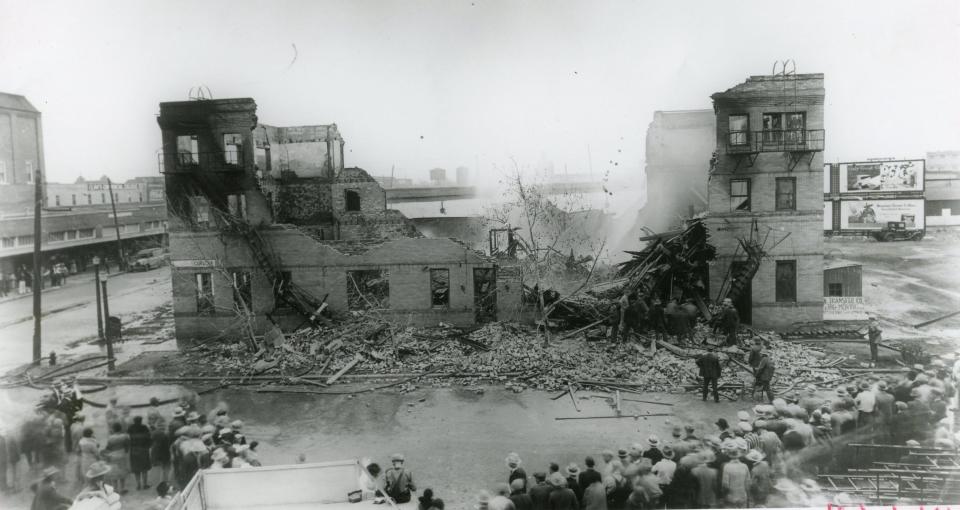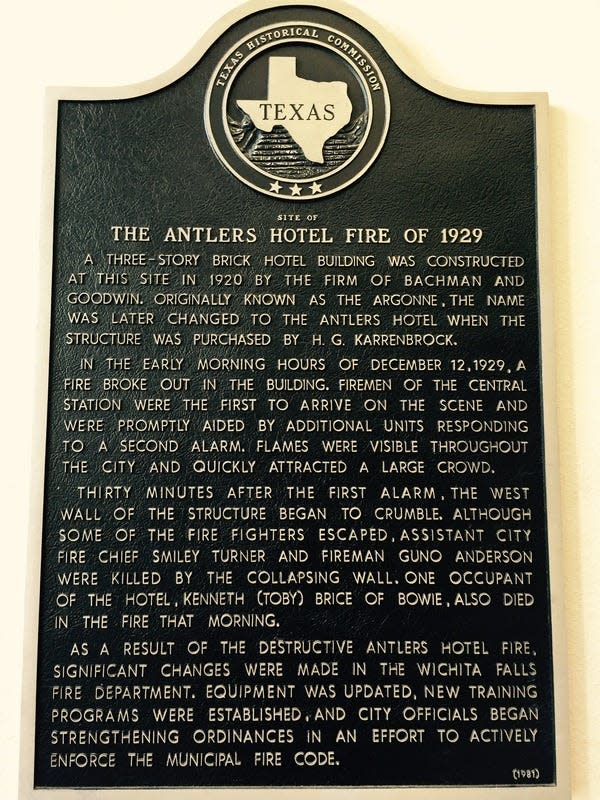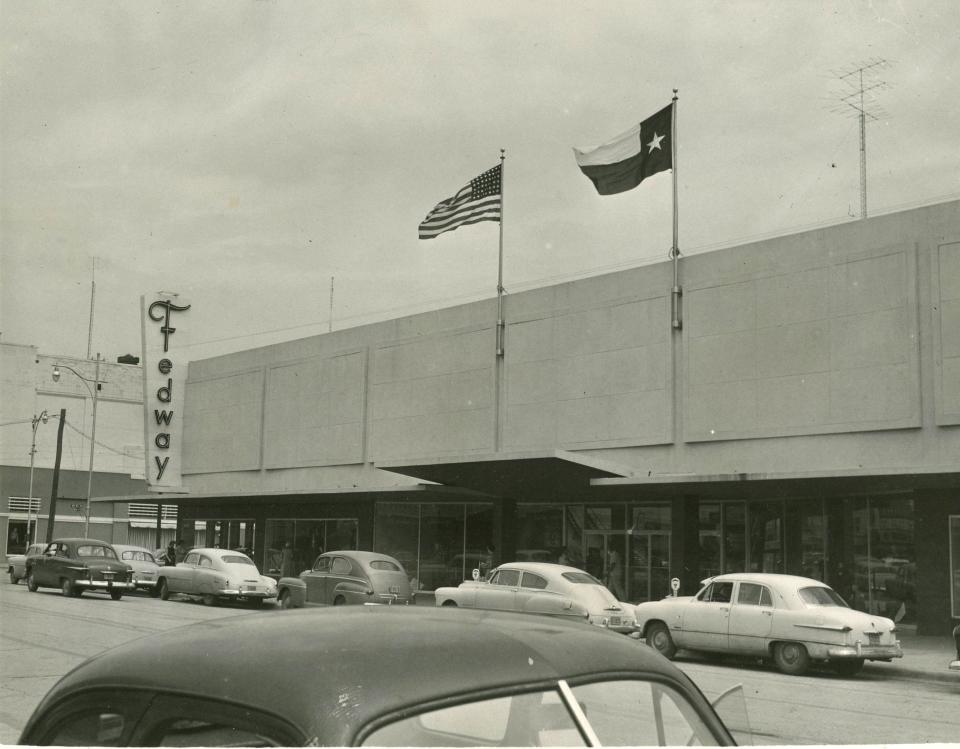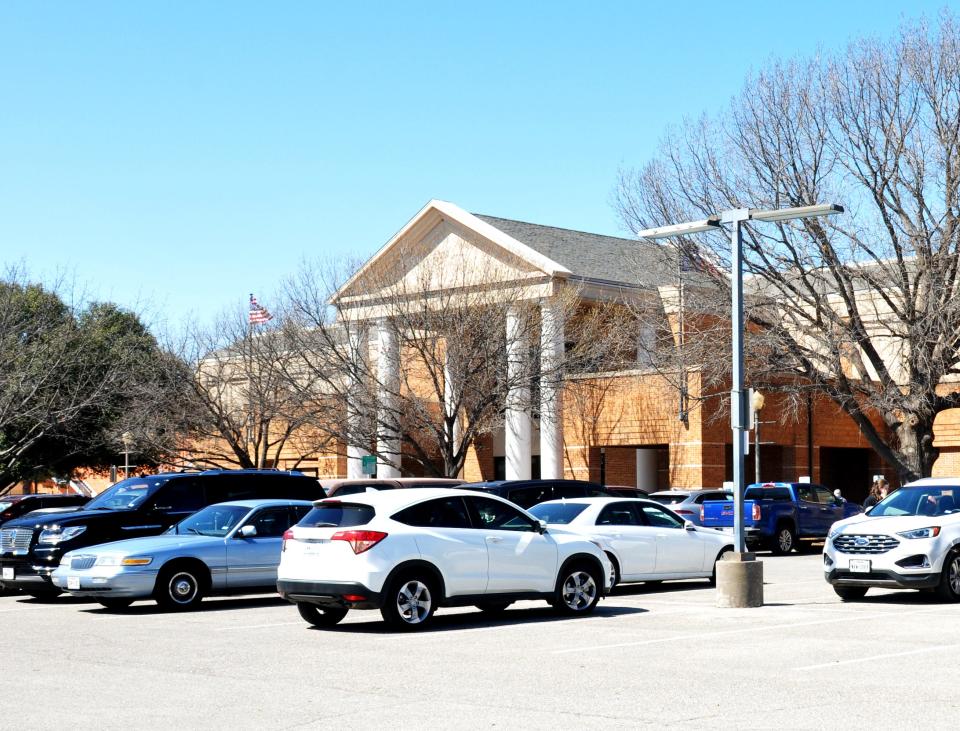This Wichita Falls site has a long and not always tranquil history
It’s a place known for its quiet and calm. A peaceful refuge from the clamor of the world.
But Indiana Avenue between 10th and 11th streets downtown — site of the Wichita Falls Public Library — wasn’t always an oasis of tranquility. Once it was a din of noise as the biggest store downtown. At another time it was the scene of a harrowing tragedy.
In the city’s earliest days, long before zoning or deed restrictions, the block was a mix of homes and small businesses.
The Antlers Hotel tragedy

In 1920, a three-story brick hotel called the Argonne was erected there. It was later changed to the Antlers Hotel, a name that would become synonymous with disaster.
Before dawn Dec. 12, 1929, flames erupted in the building. Firefighters were quick to the scene, but the Antlers was beyond saving. The west wall collapsed, killing fire Chief Smiley Turner and firefighter Guno Anderson. Bowie resident Kenneth Brice also perished.
Nine others were injured, some later telling of hair-raising escapes.
Mrs. Billy Miller leapt 25 feet from her third-floor window, suffered crippling injuries but somehow survived. The crackling glow in the night sky attracted hundreds of people to watch the worst fire in the city’s history.
Eventually new buildings rose from the rubble — a mechanic’s garage, a photography studio, a clinic, a barber shop, Mack’s Grill and Bob’s Café.

Much fanfare: Major retailer comes to Wichita Falls
The big change came in 1952. Federated Department Stores of Cincinnati, a retail behemoth, chose Wichita Falls as the first of nine sites in the southwest for its chain of new Fedway Department stores.
The company bought the entire city block bounded by 10th and 11th streets and Indiana and Ohio avenues. Federated spent $1 million to build a 90,000-square-foot, two-story structure with a parking lot to accommodate 300 cars.
When the store opened Oct. 2, 1952, an estimated 5,000 people turned out, including a who’s who of city, county, state, military and financial leaders.
The top brass of Federated stores looked on as Mayor Kindel Paulk snipped the ceremonial ribbon. Police officers were present to help manage the crowd of shoppers and looky-loos. Firefighters were called in to help people safely use the escalator.
Company president Fred Lazarus, Jr. said Wichita Falls was picked for the flagship store because of its remarkable growth. The city’s population of 68,000 had increased by 50 percent in the past decade.
Fedway sold everything from clothes to dishes and furniture to groceries. Its corporate parent spread across the country with a multitude of famous names, including Bloomingdale’s, Foley’s, Sanger Brothers and I Magnin. Under the name Macy’s, it continues as a retail holding company today.

But things didn’t work out so well with the Fedway brand. It just wasn’t a match for Sears or Montgomery Ward.
“While these stores have produced a profit over the years, the small-city department store concept does not offer Federated the opportunities that are present in abundance in our metropolitan divisions,” company officials said.
Dillard's stops in
The 11 stores of the Fedway chain sold out to Dillard’s Department Stores of Little Rock, Ark. The Wichita Falls location officially became a Dillard’s Aug. 31, 1971.
It didn’t last long.
Oilman Louis Sikes began planning in the 1960s for an enclosed shopping mall west of his mansion on what is now Midwestern Parkway. Construction began but soon languished.
After Sikes’ death, his widow sold the uncompleted project to an Arizona company. Dillard’s was among the first to move, leaving downtown and opening as an anchor store in Sikes Senter in October 1974.
City breathes new life into location
The vacant building downtown might have become a massive white elephant, but by 1977, the city of Wichita Falls was on a mission to create an activities center.
It was not a concept that sat well with voters, who turned down proposals to build activities centers in 1967 and 1974. But with community leaders complaining the city had no good place for large gatherings, the City Council sent City Manager Gerald Fox on a mission to find a suitable place.
Fox proposed the former Dillard’s building for a $1.2 million purchase and renovation to be paid through a hotel-motel occupancy tax. As part of the move by Dillard’s to Sikes Senter, the building fell under the ownership of Sikes Corp.
The city bought it for $465,000 in September 1977. Cost overruns ultimately meant the city paid substantially more to obtain and renovate the building, and it did not officially mark its grand opening until late September 1979.
For the next 17 years, the building hosted business and social meetings, seminars, art exhibits, car shows, dog shows, boat shows, banquets, dances and gun shows.
In 1992, Wichita Falls residents had a change of heart and voted to build a $25 million Multi-Purpose Events Center along the Wichita River just north of downtown, consisting initially of an agriculture center and an exhibit hall.
By 1996, the activities center at 10th and Indiana was essentially out of business.
But not for long.
Check out the site's latest chapter

As early as 1990, city leaders were concerned the venerable Kemp Library on Lamar Avenue, constructed in 1917 by philanthropist Joseph A. Kemp, was too small and needed considerable work.
The City Council considered expanding and renovating the Kemp and looking at other sites that could be converted into a library.
Those possibilities included the abandoned Sears store downtown, an entertainment complex in Century City, a vacant space on Jacksboro Highway and the vacant Edison’s store on Kemp Boulevard south of Sikes Senter.
In 1996, a citizen’s advisory committee recommended moving the library to the former activity center.
After a $6 million renovation, the hotel-cum-department store-cum-activity center became the Wichita Falls Public Library in 1998. Its former location, one of the most historic buildings still standing in Wichita Falls, became the Kemp Center for the Arts.
After a long a varied history, 10th and Indiana has earned its peace and quiet.
This article originally appeared on Wichita Falls Times Record News: Wichita Falls' library site has a long and not always tranquil history

